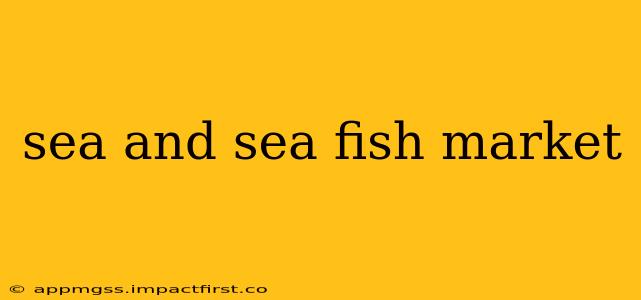The ocean's bounty provides sustenance and livelihoods for millions worldwide. The sea and the sea fish market are intrinsically linked, with the health of one directly impacting the other. This exploration delves into the multifaceted relationship between our oceans and the global seafood industry, exploring the challenges and opportunities that lie ahead.
What are the different types of fish found in the sea?
The sheer diversity of fish found in the sea is staggering, varying vastly depending on the ocean's region, depth, and temperature. We can broadly categorize them into several groups:
-
Pelagic Fish: These inhabit the open ocean, often swimming in schools. Examples include tuna, mackerel, herring, and sardines – many of which are commercially important.
-
Demersal Fish: These live on or near the seabed. This group includes cod, haddock, halibut, and many types of flatfish. Their populations are often more vulnerable to overfishing due to their habitat's accessibility.
-
Reef Fish: Found in coral reefs, these brightly colored fish are incredibly diverse. Many are smaller, but some, like groupers and snappers, are valuable commercially. Their habitats are fragile and susceptible to damage from pollution and climate change.
-
Deep-Sea Fish: These remarkable creatures are adapted to the extreme pressures and darkness of the deep ocean. Many are bioluminescent, and some are only recently being discovered and studied. Their commercial fishing is less prevalent but poses unique environmental concerns.
What is the sea fish market?
The sea fish market encompasses the entire chain from catching fish to its final consumption. This includes:
-
Fishing: This can range from small-scale artisanal fishing to large-scale industrial trawling. Sustainable fishing practices are crucial to ensuring the long-term health of fish stocks.
-
Processing: This includes cleaning, filleting, freezing, canning, and other methods of preparing fish for sale.
-
Distribution: This involves getting the fish from the fishing grounds or processing plants to wholesalers, retailers, and ultimately, consumers. Efficient and cold-chain logistics are essential to maintain quality.
-
Retail: This includes supermarkets, fishmongers, restaurants, and other outlets selling fish to the public.
How is the sea fish market doing?
The sea fish market is a complex and dynamic sector. While it provides significant economic benefits and protein sources, it faces considerable challenges:
-
Overfishing: Many fish populations are being depleted due to unsustainable fishing practices. This threatens biodiversity and the long-term viability of the industry.
-
Illegal, Unreported, and Unregulated (IUU) Fishing: This poses a significant threat to fish stocks and undermines efforts to manage fisheries sustainably.
-
Climate Change: Rising ocean temperatures, ocean acidification, and changes in ocean currents are impacting fish populations and distribution patterns.
-
Pollution: Plastic pollution, chemical runoff, and other forms of pollution contaminate the oceans and harm marine life.
How does the sea fish market impact the environment?
The environmental impact of the sea fish market is profound. Overfishing leads to biodiversity loss, disrupting marine ecosystems. Bycatch—the unintentional capture of non-target species—causes significant mortality among marine mammals, seabirds, and other marine life. Pollution from fishing activities and runoff from land-based sources further degrades ocean health. Sustainable practices are critical to mitigating these impacts.
What are the future prospects of the sea fish market?
The future of the sea fish market hinges on adopting sustainable practices. This includes:
-
Sustainable Fishing Methods: Implementing responsible fishing practices, such as using selective gear and avoiding overfishing, is paramount.
-
Aquaculture: Sustainable aquaculture, or fish farming, can help meet the growing demand for seafood while reducing pressure on wild fish stocks. However, it must be carefully managed to avoid environmental damage.
-
Reducing Waste: Minimizing waste throughout the supply chain, from fishing to consumption, is crucial.
-
Consumer Awareness: Educating consumers about sustainable seafood choices and encouraging responsible consumption patterns can drive positive change.
The sea and the sea fish market are inextricably linked. The future of both depends on responsible management, sustainable practices, and a global commitment to protecting our oceans and the valuable resources they provide. Only through collective action can we ensure a healthy ocean and a thriving seafood industry for generations to come.
